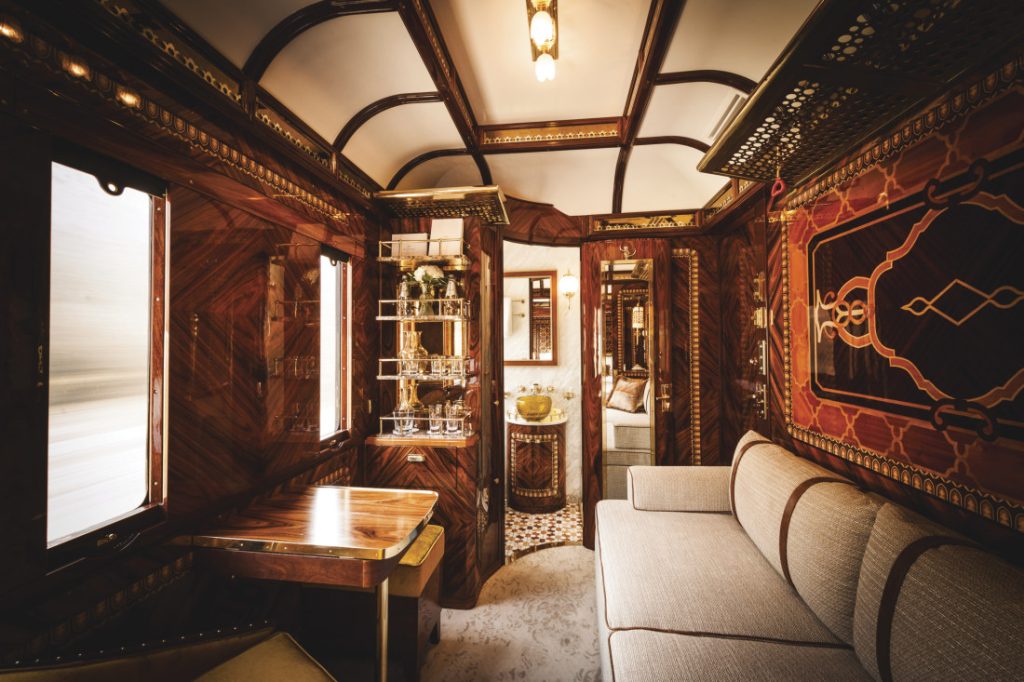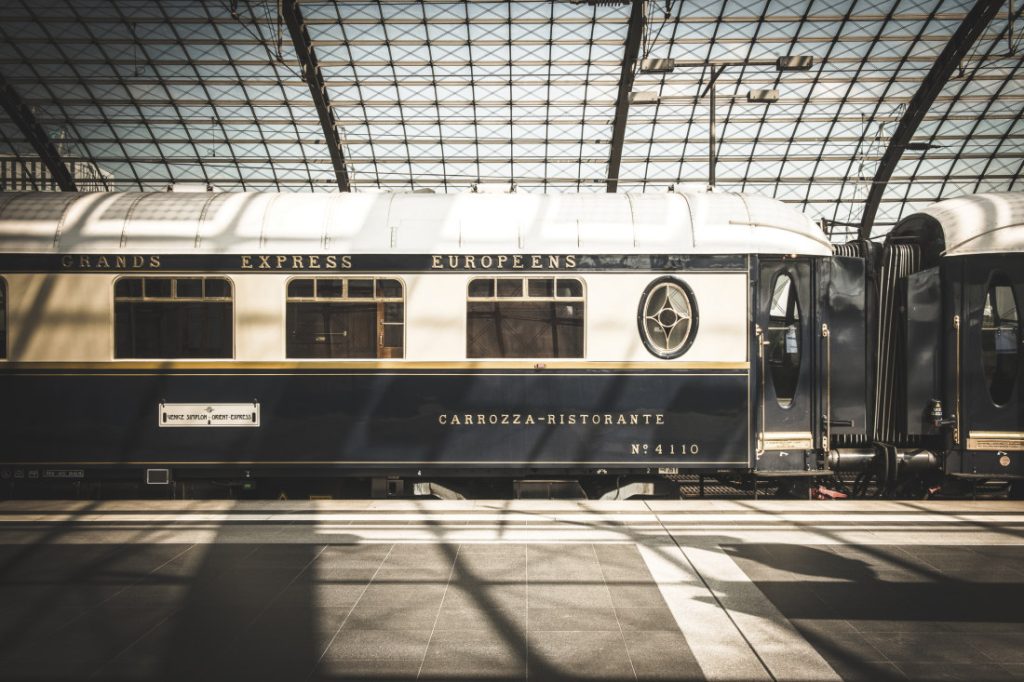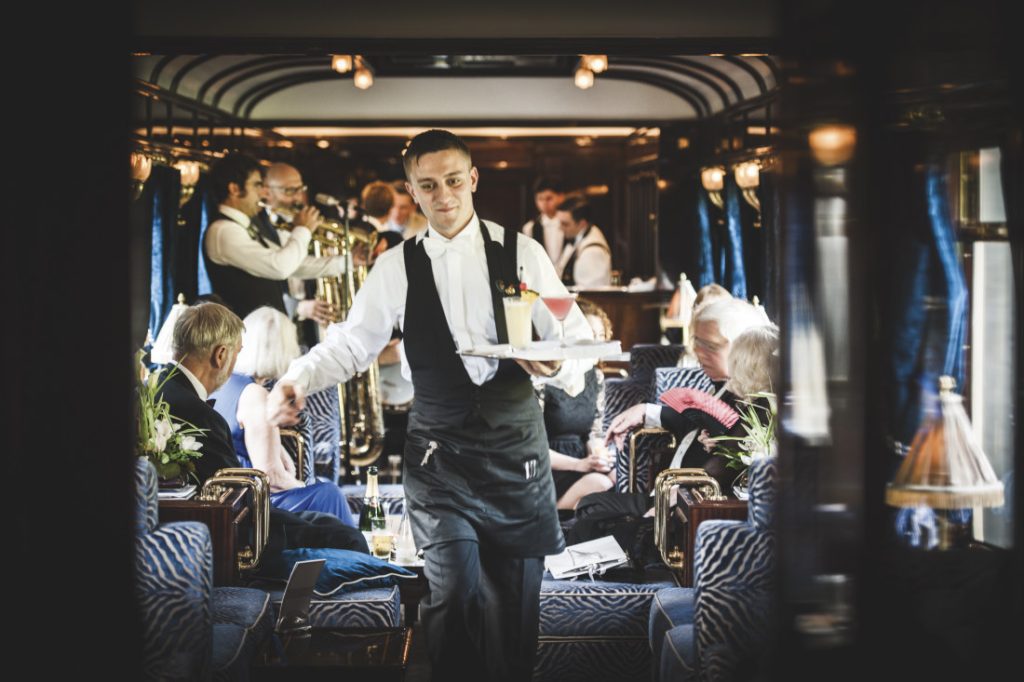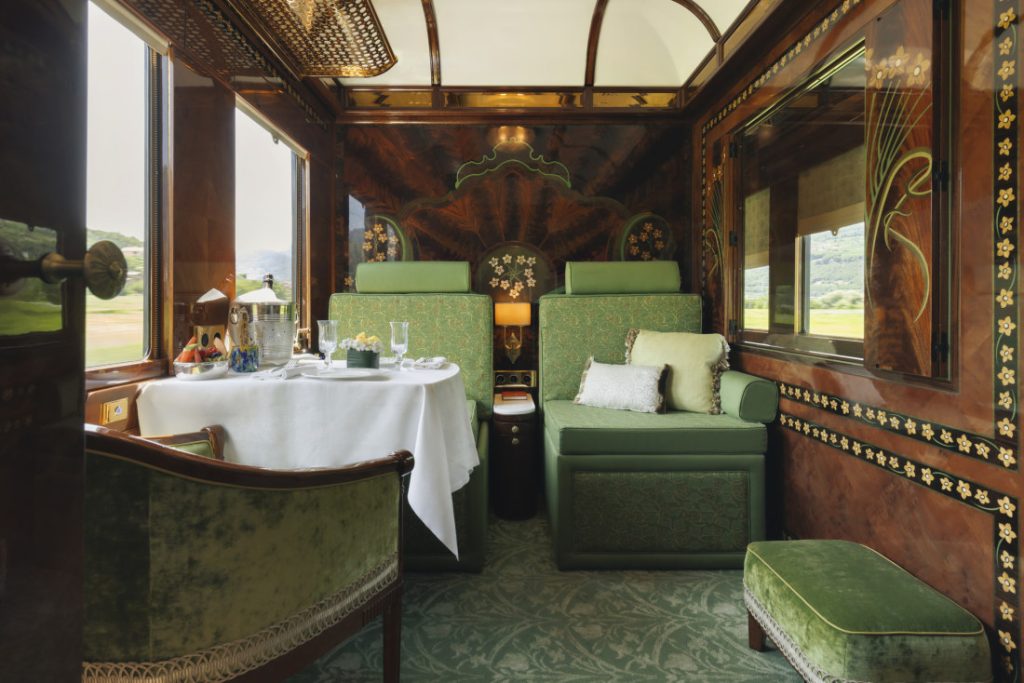It’s first service on a Thursday evening in a fine-dining establishment somewhere in Europe. Candlelight flickers as waistcoated waitstaff execute a careful choreography between tables covered in crisp linens. The air hums with conversation and the clinking of heavy silverware as a cast of patrons cloaked in couture and glittering jewels immerse themselves in indulgence. Suddenly, the entire room shifts, animating the crystal stemware as the water within it shimmers and tilts. It’s a gentle reminder that this elegant affair is unfolding aboard a luxurious overnight rail journey.
Since its first trip in May 1982, the Venice Simplon-Orient-Express (VSOE) has tracked tales of decadence and intrigue along the rails. It should be noted that the “Orient Express” has existed in several versions since its first departure from Paris to Vienna on June 5, 1883. Its renaissance was sparked when Belmond, an LVMH-owned hotel brand, acquired two original art deco sleeping cars at a Sotheby’s auction in Monte Carlo in 1977.

Over time, more carriages were collected around Europe from private owners, museums and even abandoned private gardens. Today, these carriages constitute the VSOE, the train most often associated with the golden era of luxury rail travel, serving routes that have played host to the likes of Lawrence of Arabia, Josephine Baker, Marlene Dietrich and the spy Mata Hari. (More recently, Angelina Jolie, Wes Anderson, Kate Moss and Pharrell Williams have climbed aboard.)
Indeed, the mystique begins long before you set foot onboard. Upon booking, guests are furnished with a four-page itinerary including information on passport control, check-in protocol, best luggage practice, and, most emphatically, dress code. “Smart” clothing is insisted upon during the day. Jeans, denim shorts, T-shirts and trainers are prohibited. For dinner, the dress code is “jacket and tie”, enforced with a polite warning: “Out of respect for other guests, passengers inappropriately dressed will be asked to take their drinks and meals into their cabin.” It certainly made conversation around packing interesting: What would we wear? What would everyone else be wearing? What if we’re confined to our cabin?
Upon arrival at Paris Austerlitz, white-gloved attendants escort you to the platform, a short walk that offers the chance to marvel at the train in all its royal blue glory; red carpets roll out of each carriage. Once in (my travel companion and I were in adjoining Historic Cabins with a door that could be closed for sleeping and privacy or kept open for gabbing and shameless photo sessions), we were offered a glass of champagne by Jonathan, our blue-uniformed, white-gloved butler, for the journey to Venice. With a clink of Baccarat crystal, and a full train, we were off.

Luxury train travel is on the rise, partly thanks to travellers who are climate conscious, and partly due to the trend towards slow travel. The EU is aiming to double high-speed rail use by 2030, and a cavalcade of new rail lines and itineraries have been launched this year alone.
In December, the VSOE introduced an overnight trip from Paris to Bourg-Saint-Maurice in the Alps, and in June, a Paris to Portofino service will be inaugurated.
The VSOE operates seasonally between March and December, featuring 17 meticulously restored carriages from the 1920s and 1930s with routes from Paris to Venice, Florence, Rome and Cannes. The original route, five-day trips between Paris and Istanbul, will relaunch in June as an annual offering, just in time for Turkish Airlines’ Sydney to Istanbul direct trajectory set to launch later this year.
Our cabins, beginning at £2920 ($5535) per person for the overnight Paris to Venice leg, feature a couchette seat, transformed into single beds while we were in the dining car for dinner. While these cabins do not have their own showers or toilets (the latter can be found at the end of each carriage), fear not: blue monogrammed slippers and an elegantly printed robe ensure those short steps remain sophisticated.
Those looking for an even more opulent experience can book a Suite which consists of a sitting area with plush seating during the day, converting to a double bed for sleeping and the option of private amenities, or one of the six Grand Suites can be booked from £7350 per person and come with separate living areas and bedrooms, and marble ensuites.
Some original elements remain and others have been restored, alongside new work by artisans specialising in century-old craftsmanship. Renowned mosaicist Jérôme Clochard, who restored ancient mosaics in venues including the Palais Garnier, meticulously cut materials such as marble, onyx and Italian glass into exacted templates that can withstand the train’s vibrations. Philippe Allemand, master of marquetry, restored sleeper carriages by using exotic woods salvaged from antique sources, often comprising thousands of elements in each panel.

Over the 26-hour trip, the dining car manager does their best to ensure a rotation of guests so that they may experience the unique decor of each of the three dining cars, L’Oriental, Côte d’Azur and Etoile du Nord. As we make our way to 3674, the Bar Car, we pass blue-uniformed staff shovelling coal into heaters in each carriage. The smoke soon gives way to perfume, and the sounds of the resident pianist, hard at work on the baby grand piano. In practice, the “smart” dress code seems to translate to a lot of tailored linen separates and swishy floral dresses.
I observe couples, mostly in their 40s and 50s, a mother-daughter duo and some very chic seniors. In the time it takes to finish a cocktail, our rooms have been tidied and readied for us to refresh before dinner; the mosaic “closet” has been pulled open, revealing ornate glass sinks made by Verrerie du Marais, a glassblowing workshop in Riom, France. The sinks are lined with Officine Universelle Buly 1803 bathroom products, which immediately find their way into our overnight bags.

The sun dips below the kinetic blur of the horizon (made slightly blurrier by the free-flowing champagne) and patrons begin emerging from their rooms into the dining cars in tuxedos and floor-length gowns with scintillant additions. Between us, my travel companion and I spot Valentino haute couture and vintage YSL, and there are a few flapper-inspired looks, fit for carriages crafted in the Roaring Twenties.
It all comes together to offer a sense of occasion around the culinary offerings of Michelin-starred executive chef Jean Imbert, of Paris’ Hôtel Plaza Athénée. Imbert curates seasonal menus (lunch and dinner are three-course affairs) based on locally sourced ingredients that are collected along the journey. Lobster and caviar feature prominently and the kitchen is prepared with alternatives for allergies, aversions and alternative tastes.
We take our time at dinner, rolling into the more subdued second service, deciding to retire early to make the most of the mountainous views at daybreak – although there are reports of festivities in 3674 until the wee hours.
Perhaps it’s the near non-existence of phone coverage or the meditative rocking of the carriage, but I have one of my better sleeps in recent memory, waking up to the train snaking through snow-dusted landscapes. Breakfast is delivered to our cabins and the day passes in a vacuum – at once speeding and standing still.

As we pull over the water towards Venice, chef Imbert delights us with a final treat, small plates of decadent pâtisserie bites that sweeten bitter thoughts of farewell. Within minutes of pulling into Venice Santa Lucia station, guests are piled quickly into private water taxis and delivered to hotels.
Back home in Paris the following day, the view outside my window is woefully unchanging. The sensation of pitching, what the French call mal de terre (land sickness), has not quite lifted. I pick my way to my bathroom in VSOE’s azure slippers. The mythology continues, at least around my apartment.
AFR
